By Ria Convery
All photos, maps, and illustrations courtesy of the Massachusetts Water Resources Authority unless otherwise noted.
Have you ever wondered where your water comes from? Well, it’s kind of a long story. The short answer is that Belmont, like most of eastern and central Massachusetts, gets its water from two reservoirs of the Massachusetts Water Resources Authority (MWRA): the Quabbin Reservoir in Belchertown and the Wachusett Reservoir in Clinton.
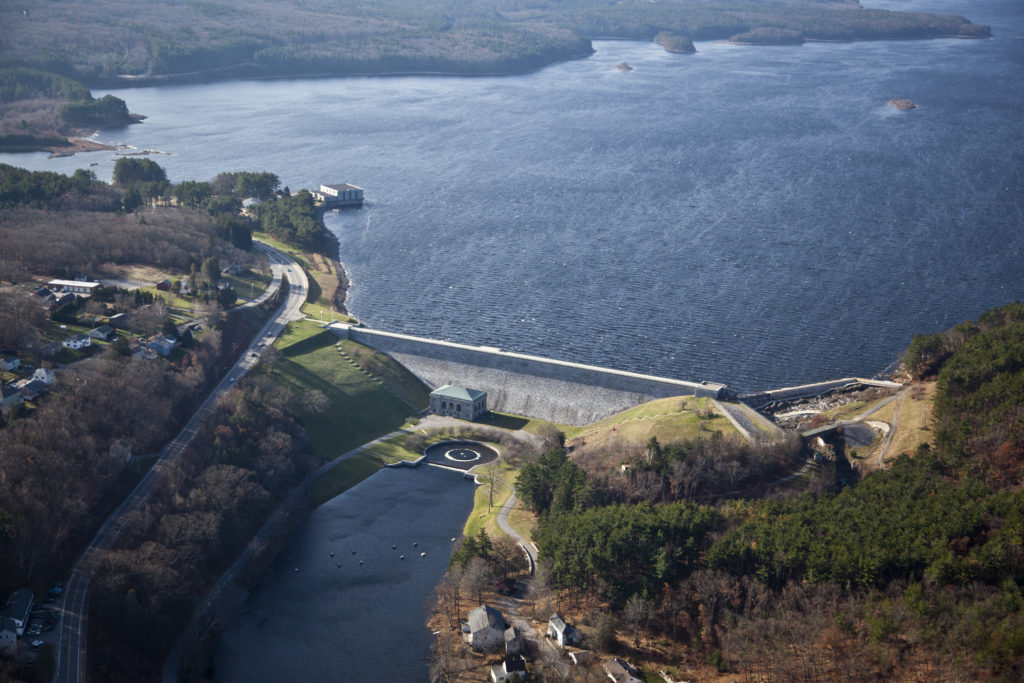
The Wachusett Reservoir was the largest man-made reservoir when it was constructed in the 1890s, below, by damming the Nashua River in the Worcester County town of Clinton, 35 miles west of Boston.
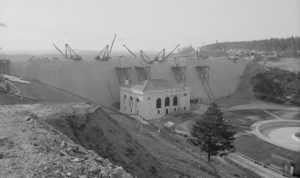
General Plan of the MWRA Water System
Our region’s water system is one of the oldest in the country. Its long history started with local wells in the 1700s, then progressed to engineering feats like the Cochituate system and the Sudbury system as metropolitan Boston looked further westward to satisfy its growing water needs.
By the late 1880s, planning began for the Wachusett Reservoir, 35 miles west of Boston. At 65 million gallons, it was the largest man-made reservoir of its time. The Wachusett Reservoir was created in the 1890s by the impoundment of the Nashua River and it is still in daily use today.
When the Wachusett could no longer meet the demands of the metropolitan area, the Quabbin Reservoir was built in the 1930s in the Swift River Valley, about 65 miles west of Boston. This reservoir famously required the destruction of four towns taken for the project—Dana, Enfield, Greenwich, and Prescott. It holds 412 billion gallons of water, which is about five years’ worth.
The Quabbin and Wachusett Reservoirs are filled naturally by rain and snow that are collected by the watersheds and form streams that eventually flow into the reservoirs. More than 85% of the lands surrounding the reservoirs are covered in forest and wetlands, and about 75% of the total watershed land can’t be developed because of MWRA protections. Since 1985, MWRA has invested more than $130 million in watershed land purchases and restrictions. These natural areas help keep the water clean and clear. Rangers from the Department of Conservation and Recreation (DCR) test the streams and the reservoirs often to ensure safety, and patrol them daily.
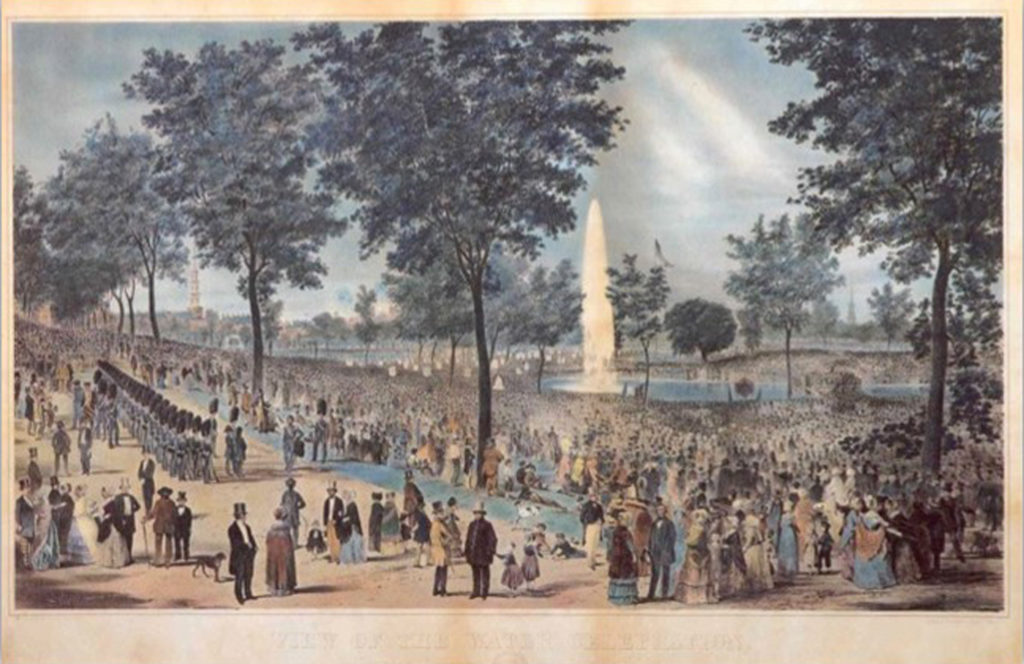
In 1848, more than 100,000 people celebrated the opening of the Cochituate Aqueduct at the Frog Pond on Boston Common. The aqueduct conveyed water for 14 miles from Lake Cochituate to the Brookline Reservoir, after which small pipelines distributed it throughout Boston.
Modernizing the Water System
When the MWRA was created in 1985, we inherited a well-designed and well-constructed 19th-century water system that had been neglected for decades. Since then, we have invested more than $2 billion to modernize the region’s water system, largely financed by member municipalities’ user rates, with some state assistance for deferred bond payments.
John J. Carroll Water Treatment Plant
The Carroll Water Treatment Plant in Marlborough, completed in 2005, uses ozone as a primary disinfectant. (Ozone is a form of oxygen gas with an odor reminiscent of chlorine.) Ozone consists of three atoms of oxygen and is created by applying an electrical current to pure oxygen in a specially designed stainless steel chamber. Ozone disinfects more effectively than chlorine alone, reduces the amount of potentially harmful disinfection by-products, and improves the clarity and taste of the water. Since the plant has been online, it has always met or exceeded regulatory requirements for water treatment.
In 2014, ultraviolet (UV) light treatment was added to meet a new EPA regulation that requires a second form of disinfection. UV light is essentially a more potent form of the natural disinfection from sunlight. It inactivates bacteria, viruses and other pathogens that could potentially be in the source water and that are the most difficult to kill, without adding more chemicals. The UV process, combined with high-quality source water from the watersheds, allows MWRA to meet regulatory requirements more cost effectively.
In addition to these disinfections, other treatments include ammonia derivatives (chloramine) to keep the water clean as it travels through miles of pipes; sodium carbonate to adjust the pH of the water, making it less likely to leach lead from pipes; and fluoride for dental health as recommended by the Centers for Disease Control and the World Health Organization.
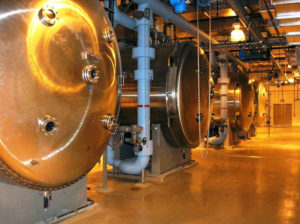
Ozone generators, top, and a UV reactor, below, are both effective disinfectants in the water treatment process.
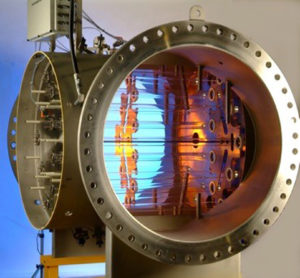
MetroWest Water Supply Tunnel
For decades, water was brought east into the city through the single-barrel Hultman Aqueduct, which became riddled with leaks. Plans for a second pipeline were shelved at the start of World War II and all but forgotten. Finally, in 1996, MWRA began the first of three contracts to mine a 17.6-mile, deep rock tunnel 200-to-500 feet below the communities of Southborough, Marlborough, Framingham, Wayland, and Weston. The $728 million MetroWest Water Supply Tunnel was fully online by March 2004, allowing the Hultman Aqueduct to be shut down for repair. By 2013, the two pipelines were working in tandem.
Covered Storage Projects
Since 1996, MWRA has replaced a century-old system of open reservoirs with seven new covered storage facilities, built to comply with the Federal Safe Drinking Water Act of 1974 (amended 1986 and 1996). With covered storage, the treated water doesn’t see the light of day until it gets to your tap. Covered storage protects drinking water from contamination by natural sources, including algae, bacteria, birds, and other animals. The tanks are located at key elevation points to help maintain the right pressure levels across the system.
The 200 million gallons of treated water in MWRA’s storage tanks are continuously used and continuously replenished. Distributing the water in storage tanks across the system keeps a supply of treated water available for communities in the event of an emergency.
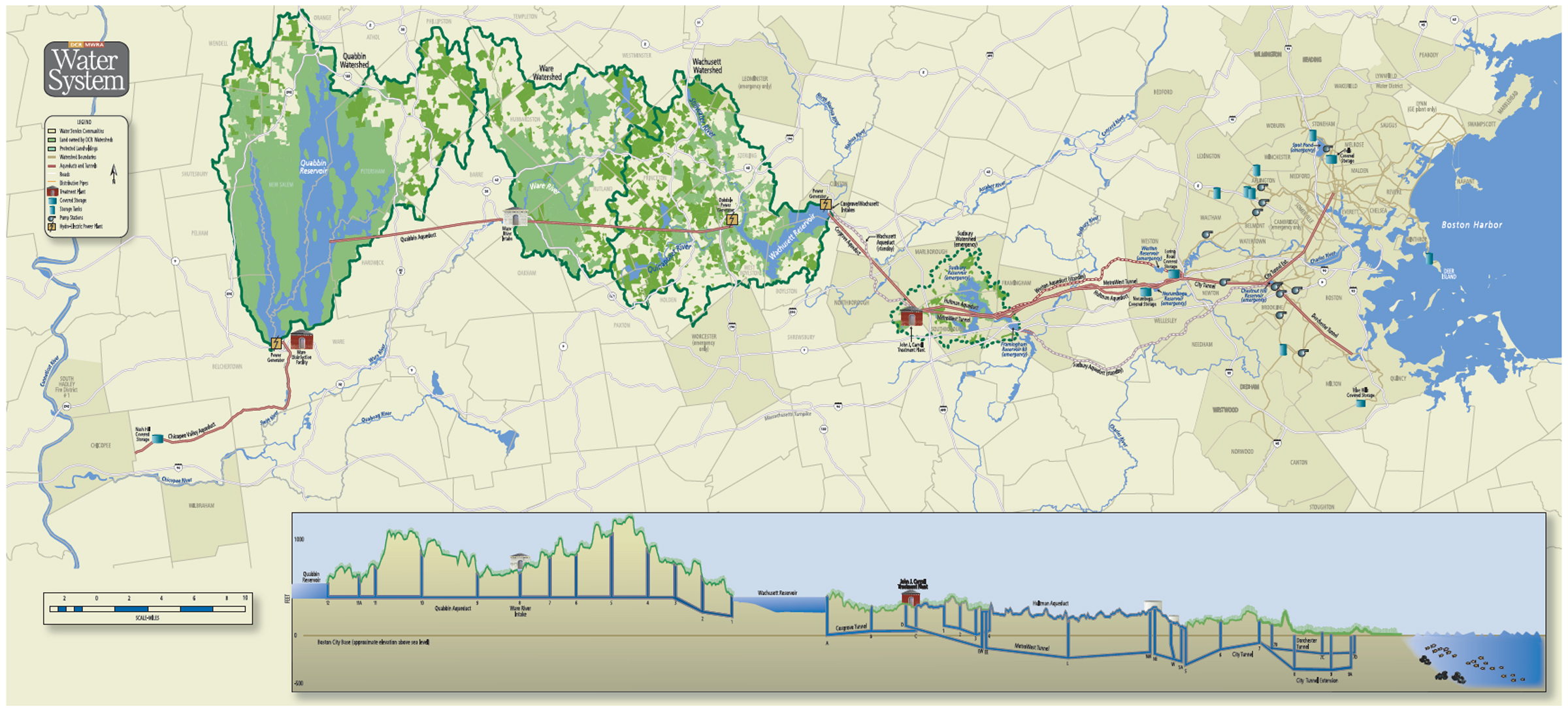
Belmont drinking water travels east, using gravity, from either the Quabbin or Wachusett Reservoirs to 1) the John J. Carroll Treatment Plant, 2) the Norumbega covered storage tank, and 3) the Weston Aqueduct Supply Mains at River Road and Loring Road in Weston. The Weston Aqueduct Supply Main 3 (water main) carries it through Waltham into Belmont.
Ongoing Pipeline Rehabilitation
MWRA continues to rehabilitate and replace our 300 miles of pipelines throughout the water system to improve both reliability and water quality. MWRA has also provided zero-interest loans to communities for local pipeline projects. Since 1998, $370.5 million in 10-year interest-free loans have been distributed to finance 407 projects to help maintain water quality in local distribution systems.
What’s Next?
Now and for the foreseeable future, MWRA will continue to focus on ensuring redundancy for each water service area. That means providing a second means of getting water to an area if something happens to the primary pipeline such as a major water main break like the catastrophic rupture in Weston in 2010.
Redundancy work is steadily underway to the north in Stoneham, Reading, and Woburn, and to the south in Boston and Dedham. Also a new emergency pump station in Marlborough will ensure the delivery of adequate water to the treatment plant in the event of a problem with the existing system.
For the first time, we have full redundancy from the water treatment plant in Marlborough to the tunnels that carry water into the metropolitan area. However, there is no redundancy for those tunnels. MWRA plans to construct two new tunnels beginning in Weston—one to the north and one to the south—to address this issue. Construction will not begin for several years, but in the interim, several smaller projects will be completed to bolster this system. One such project, currently in design, is to repair and improve the 11-mile-long Weston Aqueduct Supply Main 3 through Weston, Waltham, Belmont, Arlington, and Medford. In 2017, the MWRA hired CDM Smith and other firms to perform soil boring at 25 sites in Belmont, mostly along Pleasant Street, in preparation for this project.
MWRA also makes an effort to be green along the way. Because the Quabbin and Wachusett Reservoirs are located in the more elevated areas of central Massachusetts, more than 85% of the water we deliver is by gravity. In addition, three hydroelectric generators capture the energy of the water as it makes its way east.
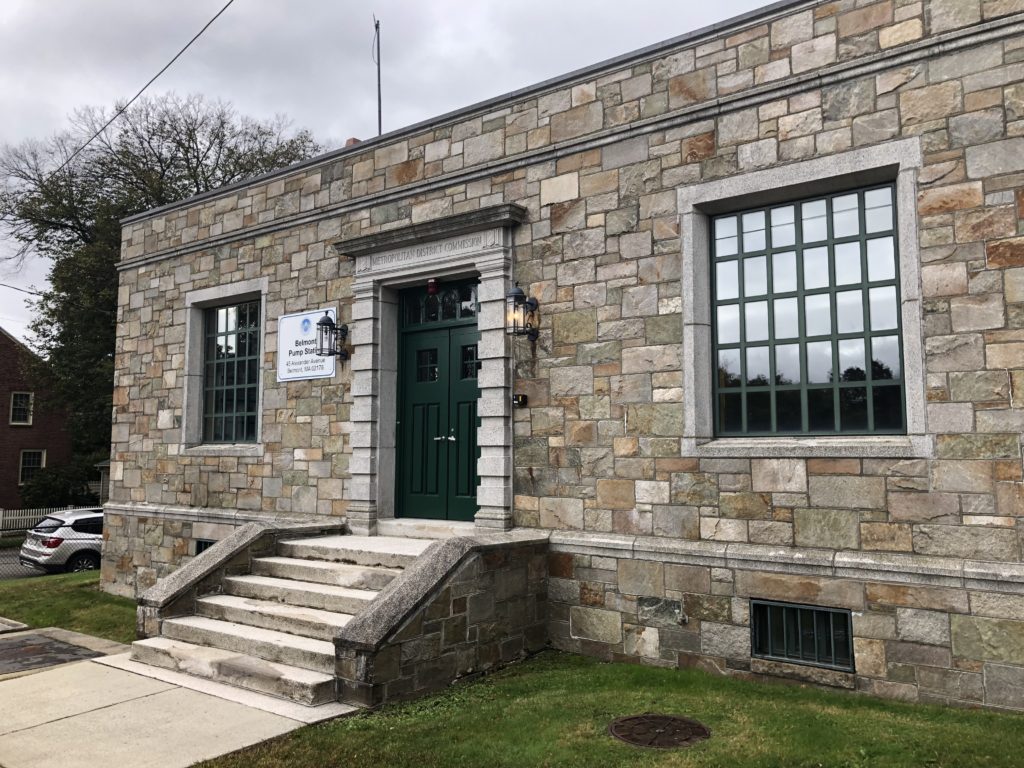
The Belmont Pump Station abuts the Claflin Street parking lot in Belmont Center.
Using Less Water
When MWRA was created, water system demand routinely exceeded the safe yield of the reservoirs (the amount you can take out without causing a shortage). In the early 1990s, MWRA began a conservation program that included finding and repairing large leaks that had been ignored for years, distributing low-flow plumbing fixtures to all homes in the service area, and educating homeowners on water-saving measures. Since then, water usage levels have continued to drop year after year from over 325 million gallons per day (mgd) in the late 1980s to around 200 mgd today. Several other factors have played an important role in conservation, such as new plumbing codes that require low-flow toilets and water-saving appliances, and the steady rise in household water bills that motivates people to stop wasting water.
How can you use less water? MWRA’s website, www.mwra.com, has lots of tips on saving water both indoors and outdoors.
Getting Water to Belmont
In 2017, Belmont used an average of 1.97 million gallons of water a day. From the Norumbega covered storage tank, water travels east to the Weston Aqueduct Supply Mains at River Road and Loring Road in Weston. Water travels through Weston, Waltham, and into Belmont through Weston Aqueduct Supply Main 3. Belmont receives water from three different MWRA pressure zones (depending on the elevation), and then delivers it to customers via three separate pressure zones in town.
MWRA’s Belmont pumping station on Alexander Avenue is the main source of water for the Intermediate High service area. It pumps up to the Arlington Covered Reservoir, feeding portions of Belmont, Arlington, and Watertown. The pump station was constructed in 1937 and most recently upgraded in 2009.
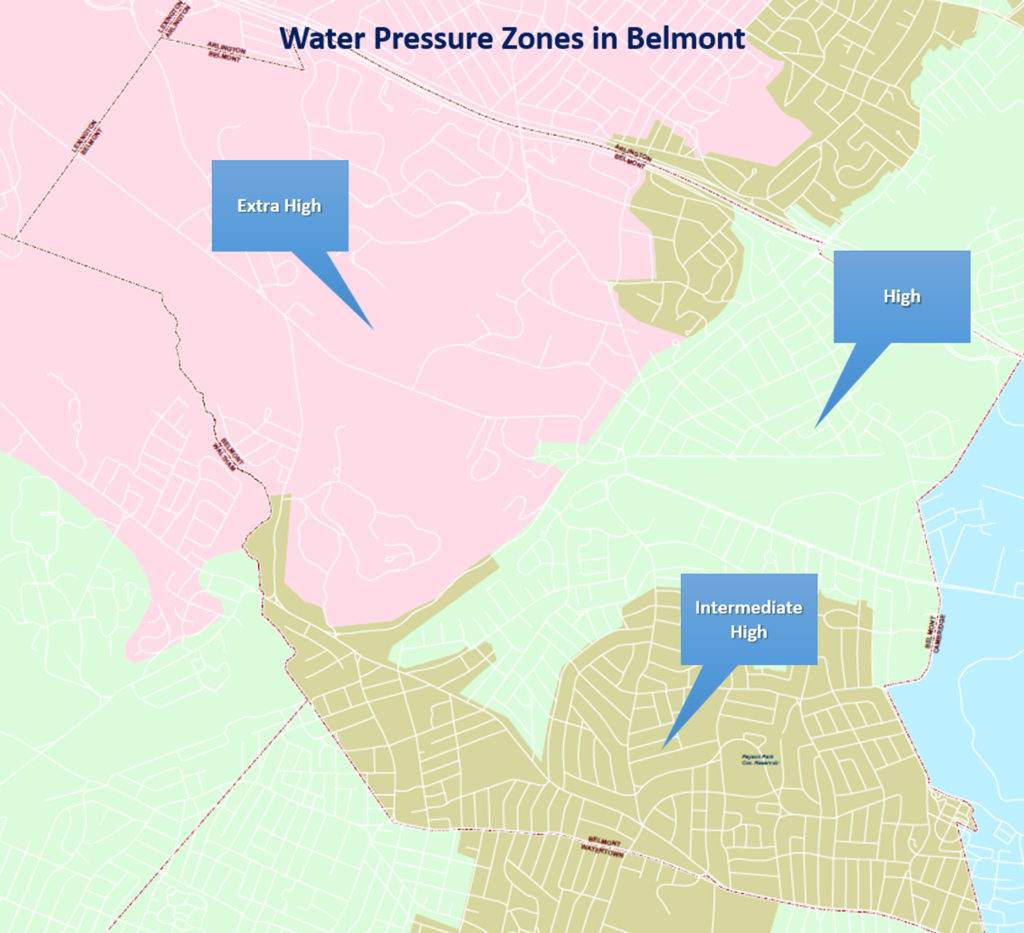
Water service areas are determined by elevation. Higher locations require pumping.
How Do You Know the Water is Safe?
MWRA tests the water at every step on the way to your neighborhood—from the reservoirs, to the treatment plant, to the covered storage facilities, to the pump stations and tanks. We test for a number of different water quality parameters in real time, so anything out of the ordinary sets off an alarm for staff to investigate.
In addition, MWRA performs hundreds of thousands of tests each year for 120 different contaminants. MWRA water routinely meets every state and federal water quality standard.
These test results are reported to each household every June in MWRA’S annual Water Quality Report, required by the US EPA (Environmental Protection Agency). Also, a monthly Water Quality Report is available online or by subscription (details at mwra.com).
What about lead?
First, it’s important to note that there is no lead in MWRA’s source water or the pipes that carry it. However, it can be found in lead service lines to some older homes (although Belmont has very few) and in some newer brass fixtures. We treat the water to make it less likely to leach the lead out of these pipes. As a whole, the water system has been below the regulatory action level for lead for the past 15 years, and Belmont regularly passes the annual lead sampling.
The bottom line is that your tap water is clean, safe, and tastes great. Drink up! (And where does it go when you flush? We take care of that, too. But that’s another long story for another day.)
Ria Convery is MWRA’s Communications Director. MWRA provides wholesale water and sewer services to 61 cities and towns in eastern and central Massachusetts. You can sign up for notifications about projects in your area at mwra.com

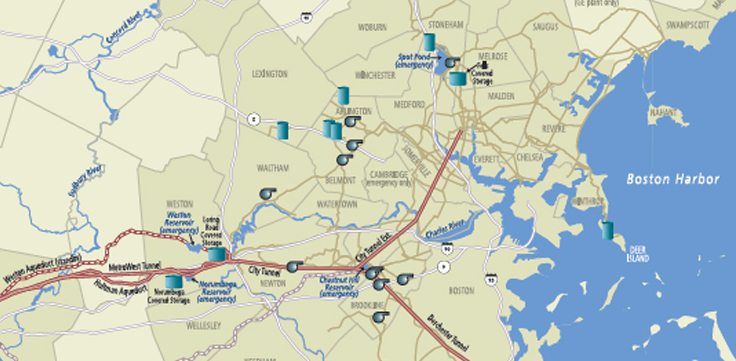

Sorry, the comment form is closed at this time.